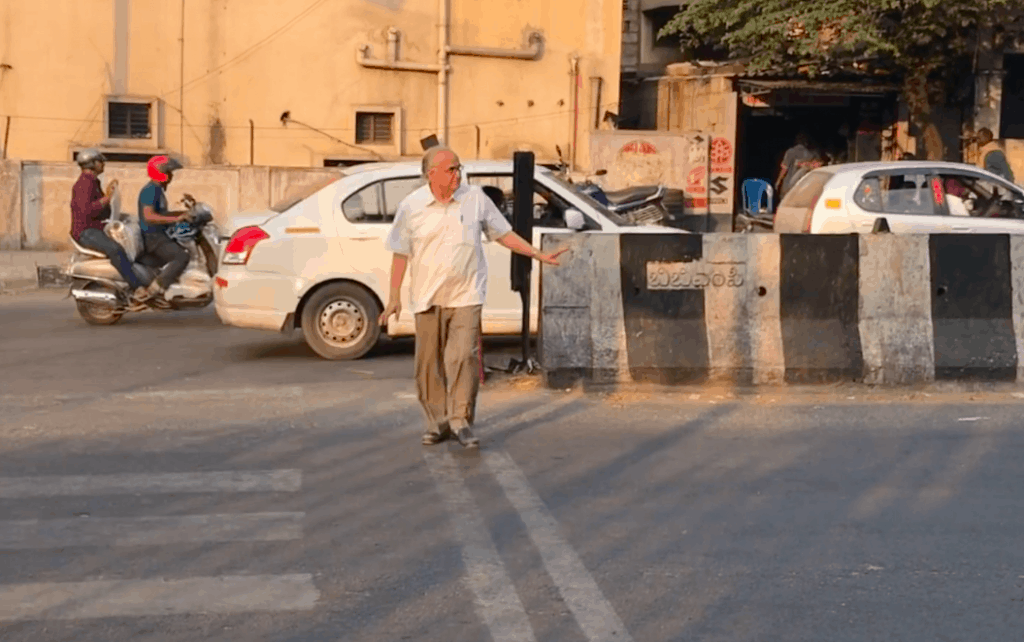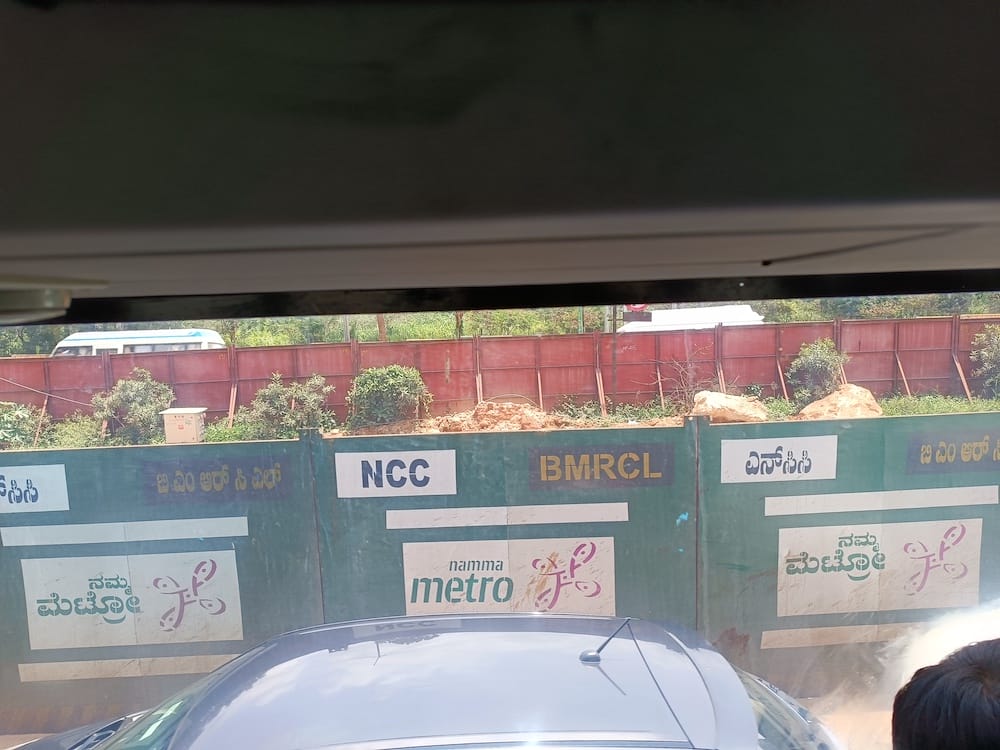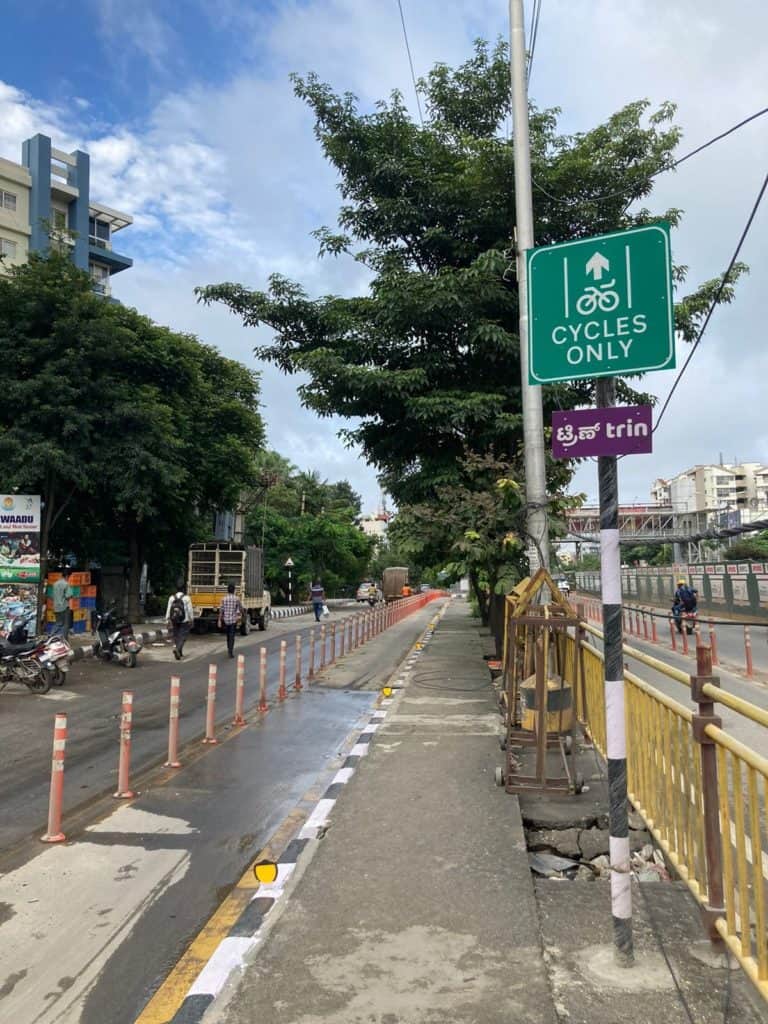In part one, I wrote about my experience as a regular user of public transport. I described what it is like to commute by walking, by bus, and by cabs and auto rickshaws.
This article will provide insights about using the metro and my perspective as a pedestrian. Most importantly, I will also offer suggestions on how the government and other entities can improve public transport.
Namma metro
I simply love the metro. It is unimaginable that public transport can be enjoyable – neat, clean, air-conditioned, well-behaved people, always on time, etc. There is hope!
But advertisers make the metro cars look ugly, I saw a metro train the other day with every inch of it pasted with Amrit Kal stuff.

Read more: The good, bad and ugly world of city public transport
The issue with walkways
Crossing a road is a nightmare. Underground or overhead walkways could do with better designs, access and maintenance. The lifts are mostly non-functional. The steps do not conform to standards required for step-risers, thereby making them unfriendly and difficult to climb especially for the aged or people carrying some luggage. They are badly maintained and are filthy. Many are badly lit. You wonder about the basic purpose of the overhead walkways – are they for crossing the roads safely or for the benefit of advertising intermediaries? No wonder people who generally prefer shortcuts, rush to cross the roads below at great risk to their lives.

Suggestions to improve public transport
These suggestions are not restricted just to vehicles, roads and footpaths, but includes other factors and entities affecting it.
- Governance
- Parliament/State Legislature must pass laws to allow a system to have citizens forming pressure groups to ensure performance by all statal/ parastatal agencies and bodies.
- State policies on the Automobile industry must change. The policies must address integrated transport networks and systems, intertwining railways lines, metro lines, bus lanes; buses, cabs, auto-rickshaws, motorised two-wheelers, bicycles, pedestrians; private cars. And except where unavoidable, not allow/employ small transport vehicles like Tempo travellers and smaller multi-seater vehicles.
- Citizens and the government must realise that Bengaluru cannot sustain its so-called “growth” because the demand forever keeps outstripping the infrastructure. There is no concern regarding viability and sustainability. The more the knee-jerk solutions to problems – especially infrastructure-related – the more chances the same problems reappearing with more deleterious impact after implementation of a ‘solution’, because the root cause of the problem is conveniently ignored. The so-called growth of Bengaluru must be curtailed.
- Economic power centres / cities / towns with complete infrastructure must be set-up by the government at least 300 kilometres from Bengaluru. If infrastructure is good, industries/businesses will flock to such places, relieving the stress on Bengaluru.
- MPLAD & MLALAD funds allocated must carry riders that their use shall be in conformance with specified standards in all works and respects, and must be frozen if found flouting rules and standards.
- The administration/government must ensure that its agencies and employees do full justice to the payments they receive/salaries they draw.
- Infrastructure & Large Projects
Please don’t forget plans, designs, specifications, guidelines and quality standards whether you are making roads or flyovers or elevated corridors or underpasses, underground or overhead pedestrian crossings, cycle tracks or footpaths.
- Create flyovers and other such huge projects only if really necessary.
- Make project plans – flyovers, elevated roads, metro lines, underpasses, underground or overhead road crossings etc. keeping timelines small. Speed them up starting from the stage ofdrawing board itself. Else they inconvenience every citizen. It is not as if the resources are limited. If resources are really limited, schedule the projects rather than starting many simultaneously because unfinished and long / delayed projects cause more issues than short ones.
- Take up more metro line projects in different parts of Bengaluru parallelly instead of in tandem spread over decades. But with adequate parking space for commuters to leave their vehicles or adequate walking space around the stations.

- Don’t think of any project without thinking of all entities that can/will impact the project implementation; have an overall agency coordinating actions of all such entities.
- The project entities shall not wash their hands off the project timelines by pointing to the failure or delays by other entities. It must be a defined responsibility of every project management to track and demand timely inputs from the other agencies involved.
- Do not approve any plotted projects or developments of gated communities without planning for adequate external roads to service such communities. It is a shame that even today, we have huge projects like Prestige Lakeside Habitat approved as well as their further expansion without ensuring adequate external road space to handle all the inevitable traffic that will be generated. Even today, even a kilometre of the road in front of the Lakeside Habitat takes half an hour to negotiate if one is lucky. The latest example of such a mess created can be found with the Mall of Asia, near the New Airport Road (Bellary Road) as the nucleus, with impact felt in the neighbouring areas.
- When making flyovers and undertaking huge road projects, don’t be stingy with money but make the roads around / below them motor-able.
- Don’t think only of signal free corridors and forget the roads and commuters below.
- Never forget that roads are meant for movement, not for shopping / entertainment / etc. No shops, apartment complexes / office complexes (private or public / government) must be abutting the roads as they will spew hundreds of vehicles and people onto the roads, that too at several specific points of time. And people will be crossing them all the time at all points. There should be buffer zones between the roads and the various constructions on either side – whatever they be!
- Don’t make roads in the overall shape of small bottles kept in a line.
- Don’t cut up wide roads into strips for whatever reason – focus on better initial planning, for example the Ring Road.
- Close down all shops, offices and other establishments occupying basements that are meant for parking in buildings and release them for cars that are otherwise parked on the roads and footpaths.
- Have wide footpaths – they aid public transport more than one can imagine.
- All along the elevated metro line, attach cycling tracks with adequate safeguards and large elevators. These will be safe for the cyclists and this can be done right away along the existing metro lines, with minimal investment.

- Other Measures
When traffic easing solutions are brought forth, they must be well-thought and thorough with a large time horizon and total buy-in by all stakeholders. If done properly, frequent changes will not be necessary based on the whims and fancies of the officials newly put in charge. And the state must remain committed to the project irrespective of who occupies the top administrative positions. I remember many of us volunteers worked on the ORR bus lane project with the support of the then authorities, but over the next few years the project was abandoned, if my understanding is right.
- Introduce more air-conditioned buses with adequate emphasis on making the rides comfortable, and retrofit all existing buses with air-conditioners.
- Train the drivers and conductors well in their jobs and duties.
- Train the Transport Corporation maintenance staff not only in technical matters but also to be aware that its customers are human beings whose needs are important.
- Don’t forget to instil road sense in all users; and be tough on violators. Be aware that the road users aren’t the most disciplined. Where there is a narrow upper road placed in the middle of a wide road, vehicles block the side lanes with the intention to force themselves on to the elevated part from the sides much to the frustration of the law abiding drivers patiently idling in a queue aligned with the central elevated road. One can see this kind of phenomenon at Mekhri square, also between the Cauvery junction and the Windsor bridge, etc. And at the St. Marks Cathedral junction (MG Road), one can see a huge bus on the extreme left lane cutting across other lanes to enter Kasturba Road putting all others on the road to extreme danger. Autos, for example, in the second lane from left turning on to MG Road are at great potential risk
- Also in ensuring smooth movement of vehicles, all agencies must do their bit, e.g:
- Traffic cops must ensure that no vehicles are parked haphazardly at/near the bus stops,
- Prevent vehicles driving in the wrong side/direction (this poses a big danger to the bus commuters, especially when this happens at bus stops which are at intersections of roads),
- BWSSB fixes the leaks in water & sanitation pipes at the bus stops,
- BBMP/ESCOMS/… ensure adequate lighting at least at the Bus stops, remove transformers from the footpaths, and so on….
- Do not close the roads / hold-up traffic for significant periods of time for VIPs. It would be better to have helipads strewn across the city for such people to be moved. The same can be used by industrialists, business owners, foreign dignitaries too whose every minute is perhaps worth a fortune.
- Do not allow heavy goods vehicles to pass through the city – provide by-pass roads or restrict their entry into the city to 11 PM to 5 AM.
- ……………… because we cannot look at public transport in an isolated manner.
(If you have suggestions on improving public transport, comment below or write to us at bengaluru@citizenmatters.in)